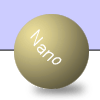Real-Time Measurements of Extent of Exfoliation
|
| |
Introduction
|
 |
| |
| The droplet length scale in a polymer blend is typically O(10)
mm whereas the dimension of the product is much larger (e.g.,
a car bumper). This presentation explores new physics which
occurs when the droplet size becomes comparable to the size
of the gap between shearing surfaces such as the distance between
parallel plates (d) or the annulus of a Couette cell. This regime
will become critical in future technologies that utilize polymer
blends and emulsions for nano and micro scale processing. Scientifically,
this problem also offers much promise for experimental and computational
investigations since the effect of droplet confinement on morphology,
stability and breakup had not been investigated until our group
tackled the problem.
|
| |
Approach: Flow Visualization using Shear Cell / Simulations
|
 |
| |
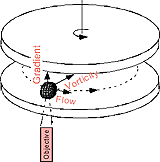 |
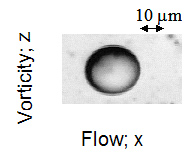 |
Droplet of polyisobutylene (PIB) in poly(dimethylsiloxane)
(PDMS)
|
|
| We visualize model blends of PIB and PDMS subjected to
simple shear flow generated in a shear cell consisting of two
clear parallel plates. Flow is observed in the plane defined
by
vorticity and the flow direction. Numerical modeling is carried
out using Lattice-Boltzmann methodology. This allows for the
direct comparison between experiment and theory.
|
| |
Results
|
 |
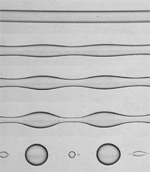 |
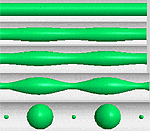 |
| Confinement strongly affects the kinetics
of thread breakup by the Rayleigh-Taylor instability and
leads to kinetic stabilization of threads (Left) experimental
results showing thread breakup with time. (Right) Numerical
Simulation
|
|
| |
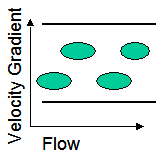 |
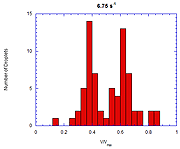 |
During the droplet string transition, two
modes are seen in velocity distribution, indicating two
layers of droplets, an effect attributed to the interplay
of droplet-droplet collisions and wall migration
|
|
| |
 |
| On confinement, emulsion droplets coalesce with each other
to form strings (threads) due to the interplay between coalescence
and breakup |
| |
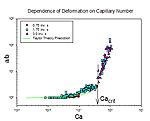 Confinement
imparts remarkable stability to emulsion droplets, and under
confinement emulsion droplets can exist at super critical Capillary
numbers Confinement
imparts remarkable stability to emulsion droplets, and under
confinement emulsion droplets can exist at super critical Capillary
numbers
|
| |
| |
Conclusions
|
 |
We see that confinement has profound effects on the structure
of blends:
Suppression of capillary breakup
String formation
Droplet layering
Droplet elongation
These results are critical for microfluidic 2 phase flows where
The confinement occurs in two dimensions, thus these effects
will be
even stronger.
|
| |
| |
Contributors:
|
 |
|
Kalman Migler, Steven Hudson, Jai Pathak, Jack Douglas and
Nicos Martys (BFRL)
|
| |
| |
| |
| |
| |
| |
| |







